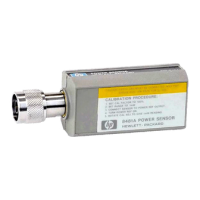Service
Chapter 336
Principles of Operation
Thermocouple Sensors
The A1 Bulkhead Assembly presents a 50 Ohm load (75 Ohm for model 8483A) to
the RF source.
The RF signal is coupled through a dc blocking capacitor and absorbed by the
thermocouples, generating a dc voltage proportional to the RF input power. The dc
voltage is routed from the thermocouples to the input amplifier via gold wires
reducing unwanted thermocouple effects. The gold wires, located in the black
plastic block, pass through ferrite beads A2E1 and A2E2. The ferrite beads increase
the self-inductance of the gold wires creating an RF choke. The result is to minimize
RF feedthrough to the A2 Power Sensor Board Assembly.
The dc output from the bulkhead assembly is applied to the two field effect
transistors (FETs) in A2U1. These transistors function as a sampling gate or
chopper. The sampling rate is controlled by a 220 Hz square wave supplied by the
power meter. The amplitude of the sampling gate output (at pin 3 of A2U1) is a 220
Hz square wave proportional to the power input. The sampled 220 Hz ac output is
applied to the input amplifier A2Q1, which is the input stage for an operational
amplifier
The Auto Zero Feedback circuit is coupled to the power sensor from the power
meter. The dc voltage used to set the zero level is applied to the input of FET A2U1
by using A2R1 and A1TC1 as a voltage divider.
When the Power Sensor is used with a Power Meter, the resistance to ground from
J1-K (Mount Resistor) allows the Power Meter to determine the sensor's dynamic
range.

